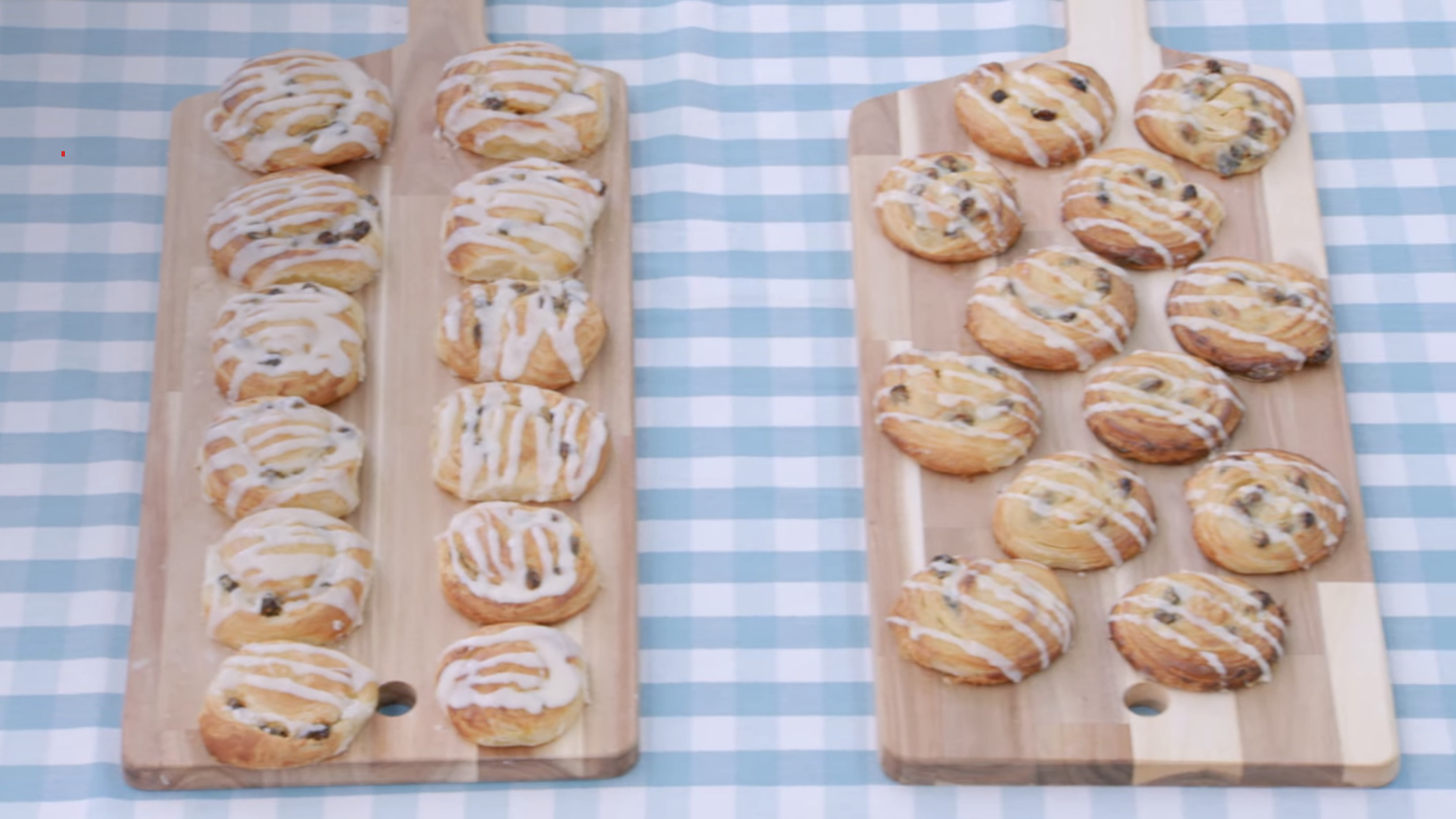
Welcome to a new series called The Not-So-Great Defector Bake Off, where Kelsey and Chris attempt to complete the technical challenges from the newest season of The Great British Bake Off in their own home kitchens, with the same time parameters as the professional-grade bakers competing on the show.
The technical challenges of The Great British Bake Off are meant to be difficult, and not just for bloggers of questionable baking expertise. The challenges are specifically formulated to push to the limit contestants who are credibly described as the best amateur bakers in the United Kingdom. Each technical challenge showcases a bake that would be considered tricky under any circumstances. The show’s judges then make a determined effort to strip the instructions of all helpful information, and then the contestants are given a strict and punishing time limit. To make matters worse, the contestants are given no opportunity to study the method, stripped-down though it may be, before the clock starts ticking. It’s no wonder that some of these bakers occasionally wind up sobbing before the challenge is over.
All of the contestants are very good bakers. When they screw up, or when they get caught staring slack-jawed at a particularly obscured step of the instructions, it’s never because they are bad at baking, or because they have failed to prepare for or to take seriously the challenge ahead. The technical challenges don’t sort the good bakers from the bad. Technical challenges, it turns out, teach you about the huge and often insurmountable gap between understanding a thing and knowing a thing.
It’s fascinating and sometimes infuriating to encounter this gap mid-challenge. Give a good cook a whole orange and a bag of confectioner’s sugar and an image of an iced bun and tell her to make icing, and she will have enough information to whip together the desired icing, by adding a little orange juice to a little sugar, stirring, tasting, adding, and so forth. Take away the image of the icing and replace it with detailed instructions—two tablespoons of orange juice stirred into 200 grams of sugar to make a stiff but pourable icing—and she will get there just as reliably, even if she can’t be sure at the end that the icing looks exactly like it’s supposed to. This is what it is to be a good cook—if you know what it is you’re trying to produce and you have the appropriate ingredients, you will reliably produce the thing. When your family compliments your cooking skills, they mean that you routinely produce delicious and well-made meals, not that you produce them entirely from memory.
Back to the icing: Take away the image and replace the instructions with “make icing,” and you have lowered the odds considerably. Take away the image, replace the instructions with “make icing,” and give the cook only as long as it takes for one efficient attempt, without any time for an iterative process, where any hesitation or misstep will make the completion of proper icing all but impossible, and the only way that she will make the desired icing is if she knows, right from the outset, precisely what the intended icing looks and tastes like, and also precisely how to make it from a whole orange and some confectioner’s sugar. That, or she can get very, very lucky.
The technical challenges reward knowledge. They permit luck. They are merely merciful toward understanding. That you could normally be counted upon to produce excellent confections, given time and instructions—that you are a good and dependable cook capable of baking many tasty delights under normal circumstances—will only get you so far. At a certain point, you will inevitably run into a method with which you retain only a passing understanding, and you will suddenly find yourself in the deepest of shit. God help you if in that moment you discover that you are a blogger who is on the hook to show photos of your fuck-ups to unforgiving readers.
The third week of the 13th season of The Great British Bake Off aired last week. It was Bread Week, which would’ve presented a stiff test under all circumstances, but was made all the more challenging when judge Paul Hollywood chose Pain aux raisins—a pastry—as the technical challenge. What the fuck.
KM: I was excited for bread week. I love bread, and after the tragedies of the very ugly first two weeks, I was thrilled that I would be able to make a little crunchy loaf that I could probably dip into olive oil and use to absorb my tears if it turned out poorly. When you told me that the dreaded Paul Hollywood had completely ignored the rules of the tent and given us a pastry, I genuinely thought I was going to cry.
CT: We of course handled this disappointment super maturely, as professionals:
I had the same vision you did for Bread Week: I pictured making a tasty rustic loaf or several delicious crusty buns, where even if they looked awful they would be very satisfying to the soul to eat. Instead, this BULLSHIT. Had you ever tried laminating before, Kelsey?
KM: Surprisingly, no! I am not much for making finicky things, and laminated dough is one of the most finicky. I have made dozens, if not a hundred loaves of bread, all nestled snugly in the Le Creuset I bought specifically to bake them. But never in my life had I laminated dough. Had you?
CT: Surprisingly, yes! Once before, I tried out laminating for a not-too-dissimilar pastry type thing. It went reasonably well the first time, but mainly this is one of the rare baking things that I understand pretty well, just like as a concept. You make a sheet of butter, you fold it into a sheet of dough, you roll and fold and roll and fold, and voila, you've got layers of dough and butter.
KM: The thing about laminating dough is they do it every single season on The Great British Bake Off as a technical challenge. So even though I hadn’t made it myself, I had a very good conceptual understanding of how to make the dough. I did not, however, feel very confident.
CT: Yes, this was the first technical challenge that I met not with outsized confidence but with dread. I did not want to be baking pastries this week! Even worse than the laminating was the crème patisserie, which I have never made before, and which I understood to be a finicky thing to make. And it really pisses me off! To be judged in BREAD WEEK by the quality of a goddamn stovetop custard. Bullcrap!
KM: I also had never made crème patisserie and did not EXPECT to have to for weeks. But I have made custard, and also crème patisserie is one of those things where the ingredients are so good (milk, vanilla, egg, sugar? Yum!) that I wasn’t that nervous about it tasting good.
CT: Right, if there was one source of comfort, it’s that the ingredients for crème pat are super straightforward and should taste delicious in combination, no matter what. It was with this spirit of I Guess I Can’t Fuck This Up Too Royally that I proceeded, Eeyore-like, into this challenge. Shall we?
Ingredients and Shopping
KM: Unlike last week, I decided immediately upon reading these instructions that I would not be purchasing raisins. I purchased so many fucking currants last week, and as we all know currants are basically small raisins, so I just used these instead. Every other ingredient (except for piping bags) I had.
CT: That was a good call on the currants, I think. I have a small child in my home and so of course half my pantry is now raisins, so I was all set. There’s nothing very perverted in these ingredients, beyond vanilla pods, which can sometimes be tricky to track down in my part of the world. And of course the dreaded golden caster sugar.
KM: Oh, I still don’t have golden caster sugar. I refuse to buy it. It’s expensive and also I cannot find it. I used an extremely old vanilla pod that I had in my little baking box in the pantry. But my real shining moment is that before I began, I remembered that instant yeast has an expiration date. Mine was September 2022. So I did the little test where you put it in warm water with some sugar and see if it’s dead. And it was alive, but like the way Frankenstein’s Monster was alive, so I went to the store and got more.
CT: That’s a nice October treat: dry yeast that can be compared to a horror monster.
KM: Yummy. Before we get into the actual baking, can we talk about the terrifying texts your wonderful wife sent me before we began?
CT: Certainly. She was so worried for us this week. Every few minutes while she was editing down the method she would poke her head into my office and be like, “Are you sure you want to do this?”
KM: Your wonderful wife sent me a series of texts, all of which were more terrifying than the last. First she told me that “this is mean. Just… mean.” Awful vibes to begin a bake. And then later she said, “Don’t expect good things from this bake. Just… don’t. :(" Because of this series of terrifying texts, I put off beginning my bake until Saturday, and also became convinced that Paul Hollywood must personally fight me for upsetting your wonderful wife who is doing such a nice thing for us by paring these recipes down to their hellish realities.
CT: There was a moment, about two minutes into what would be a 165-minute bake, when I really felt like I could attack Paul Hollywood with a rolling pin. Let’s get into it.
Stage One: Measuring, Mixing, and Rolling
CT: I entered CHAOS MODE approximately 24 hours before you this week and almost immediately I was on the brink of quitting this exercise and throwing myself into a river.
The 25 grams of butter just drove all the fight out of me. I was prepared to once again cut butter into small cubes, but 25 grams of butter is already a disturbingly small cube. To cut it down further with any precision at all would be just soul-crushingly stupid and humiliating. I just hacked it up with a knife and dropped it into the flour.
I was doing the fingertip method to push approximately one heaping tablespoon of butter into a huge pile of sifted flour and just feeling completely hopeless about this bake, about my future, about life on Earth. There is no more stupid experience available to any human anywhere on our planet than “mixing” a golf ball of butter into an ocean of flour, with no real sense of what it’s supposed to accomplish. I wanted to die.
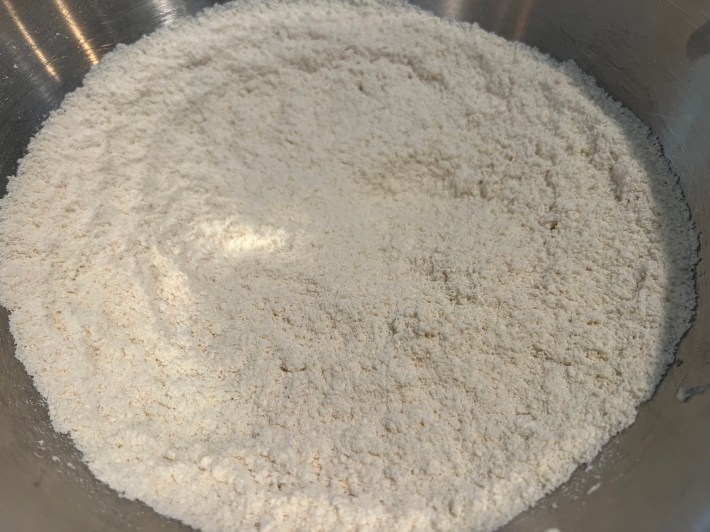
KM: This series of Slack messages sent panic through every one of my blood vessels. Every moment I was feeling better about my decision to spend Friday afternoon drinking beers and Saturday entering CHAOS MODE. When I finally did venture into CHAOS MODE, the first thing I did was read the instructions. The instructions are … sparse. The instructions also require you to have the perfect timing of a fucking prima ballerina. I am not one of these, so before I began crumbling the meager amount of butter into the 350 grams of flour, I put a bunch of timestamps onto my recipe, so I knew what minute I was supposed to be on each step so I would know whether I was behind or not. This will be important later (lol). This did however burn a full three minutes of time, because I’m bad at math and especially bad at time math.
CT: I didn’t do anything as smart as that, but this week I did not spend any time up front measuring ingredients for later use, or cutting paper, or anything like that. I had the sense that I would have to just move-and-shake and improvise but in all cases proceed forward through the method as aggressively as possible. This wound up being exactly the correct approach, even while it is offensive to my cooking instincts.
KM: Personal growth!!!! I’m so proud! This is how I always work, just chaotically throwing things into a bowl and slapping them with a wooden spoon, which is why I was excited for bread week. Bread, unlike cakes and cookies, is a rather forgiving thing to bake in terms of actual neatness. Bread does not care if your edges are straight really because it’s gonna get all rolled up anyway.
CT: Which is part of why this particular challenge was so disappointing: It’s bread week, but like we have an instruction at the top of the page that specifically tells us that our pain aux raisins should not have “tails.” Just the fussiest un-bread-like bullshit imaginable.
KM: Paul Hollywood Fight Us Challenge. Was your dough just, like … unbelievably sticky? Did you knead it?
CT: OK, so my dough was very sticky, once I added the milk, water, and egg, which I mixed together and then stirred in using a rubber spatula. And I did not feel confident that I would be able to knead it without either using an obscene amount of flour or without just getting it all over my hands and making a huge time-consuming mess. So what I did was stare at it angrily for a few seconds, and then I dumped it out onto my cutting board and just very gently smushed it around for a minute or two using my floured hands and a dough scraper, almost using the scraper as a defensive weapon every time the dough threatened to expand outward onto new surfaces.
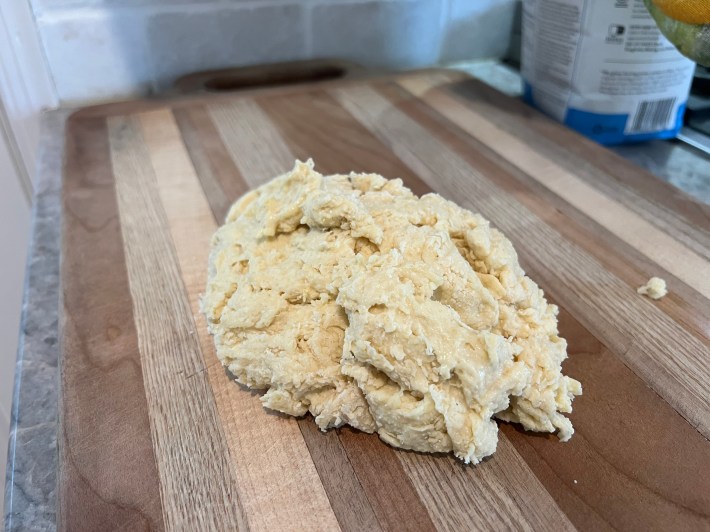
I worried that it wasn’t getting enough strict kneading, but time was EVERYTHING for me at this stage and I was determined not to fall behind. And I knew that it was going to get a lot of rolling and smushing over the next couple hours. Also it just seemed to me to be sufficiently well-mixed. Anyway, at a certain point I just scraped it all up off the surface, deposited it into some plastic wrap, and socked it into the freezer. It’s funny: Had I been in a better headspace at the outset of this bake, I almost certainly would’ve put more effort into this stage, and would’ve suffered for it later on.
KM: My dough was so sticky, too! I thought it was supposed to be sticky, so I didn’t want to use too much flour and instead used a little bowl of water to dunk my fingers into so that the dough wouldn’t stick to them. I then used a bench scraper to knead by slapping it around. A problem here is that I was very, very sore from trying to do chin-ups at the gym, so this was a miserable experience. I did it for two Bad Bunny songs, though, because it just looked lumpy until then, which was probably my fault skimping on crumbling up the butter.
CT: That’s interesting that your dough was lumpy. I did not think that mine was, but then I also handled it very little, in an effort to avoid having it swallow my hands. How did you approach the rolling and folding steps of lamination? Did you pound the butter with your rolling pin?
KM: Thank you for asking. I took one look at the big hunk of butter and realized two things: 1) It was very large and very cold and 2) I had to roll it fast so it didn’t melt. I did in fact smack it with the rolling pin as hard as I could. This was satisfying. I imagined it was Paul Hollywood’s stupid hand. I did this, to be clear, between two parchment papers. I’m not really sure if that was the right thing to do.
CT: Ha! I did the same parchment thing! My experience with all rolling was so completely miserable last week, I decided I would take no chances. I had success with the parchment sandwich last time I tried lamination and I've watched innumerable past contestants do this, so I surrounded my butter with parchment and then beat the everloving shit out of it.
KM: I found this so satisfying. I loved smacking the dough. In the end, I put the butter sheet inside its parchment papers onto a baking sheet and shoved it in the freezer. Did I have to put frozen shrimp and a bottle of vodka on the table to make it fit? Yes.
CT: I put the butter into the fridge, because my dough was in the freezer and I didn’t think I could fit both without destroying one or the other. But then just seconds later, I got panicky and pulled my dough out and started rolling it out.
KM: You should have simply removed the shrimp. Wow! Immediately? I waited six tortuous minutes for everything to be cold because my time sheet said I could and also I desperately needed to chug an entire pint of water because I was so tired from running back and forth.
CT: I was just so frantic to capture as much time as possible in the beginning, for use later on. Always there was concern about the proving of the dough weighing on my mind, and I kept hearing Paul’s voice in my head, declaring my finished pastries under-proved. To me this would be the most obvious point of failure, and I was determined to avoid it.
KM: I think that was the right move. I could have used the six minutes at the end.
CT: I yanked my dough out of the freezer, put it down on the cutting board, grabbed my rolling pin and my trusty measuring triangle, rolled up my sleeves, and prepared to roll that sucker out. But first, I had to do fucking MATH. The recipe offered the butter measurements in inches, thankfully, but I knew that the dough rectangle needed to be roughly one-third longer than the butter rectangle in order to create the desired layers, and this flustered me pretty badly.
KM: My dough was so, so sticky. While my dough was in the freezer, I drew little stars onto a big sheet of parchment paper so that I would know how big to roll it. I knew the dough was too sticky to put on the counter without me being checked into an institution at the end of this, so I rolled the dough on the parchment paper, which I also floured so much.
It’s so funny to me that, yet again, you did this math. What I did was roll my dough out to the appropriate size, slap my butter on top of it and just fold it up. Neither of these things were squares. They were both weird jagged ovals. I do not care for this one-third nonsense. I knew there needed to be three layers of dough and two of butter, so I just kind of did that a little messily.
CT: I definitely did the math. It’s just something my brain will not allow me to escape.
KM: This guy loves math!
CT: I rolled out the dough, slapped the butter on it, folded the extra third down, and folded the bottom up so that it made a nice envelope. This went very well, and I took great encouragement from this step. I had some trouble wrapping the envelope to go back into the freezer because I somehow have only the world’s worst cling wrap, but otherwise this first laminating fold went very smoothly. I felt great.
KM: I did not really wrap my dough either. I kind of wrapped it in the parchment paper like a burrito and shoved it in the freezer to make the crème pat. That said, it did LOOK right at this point, so I was feeling good! Great, even! My confidence shifted immediately from -500,000 to I WILL FIGHT GOD.
CT: We were definitely sending each other absurdly boastful Slack messages at this point.
After this first laminating fold, I was feeling so powerful that I immediately launched into the making of crème patissiere.
KM: Same! What I knew about the crème pat was that the milk should be warm, poured into the other shit, and then returned to heat. So I did this. I also threw the vanilla pod into the milk while it got hot. I don't know if that was correct, but it smelled incredible. To be honest, this also reinforced my confidence because it worked fine! It got thick and tasted good and was done in like seven minutes.
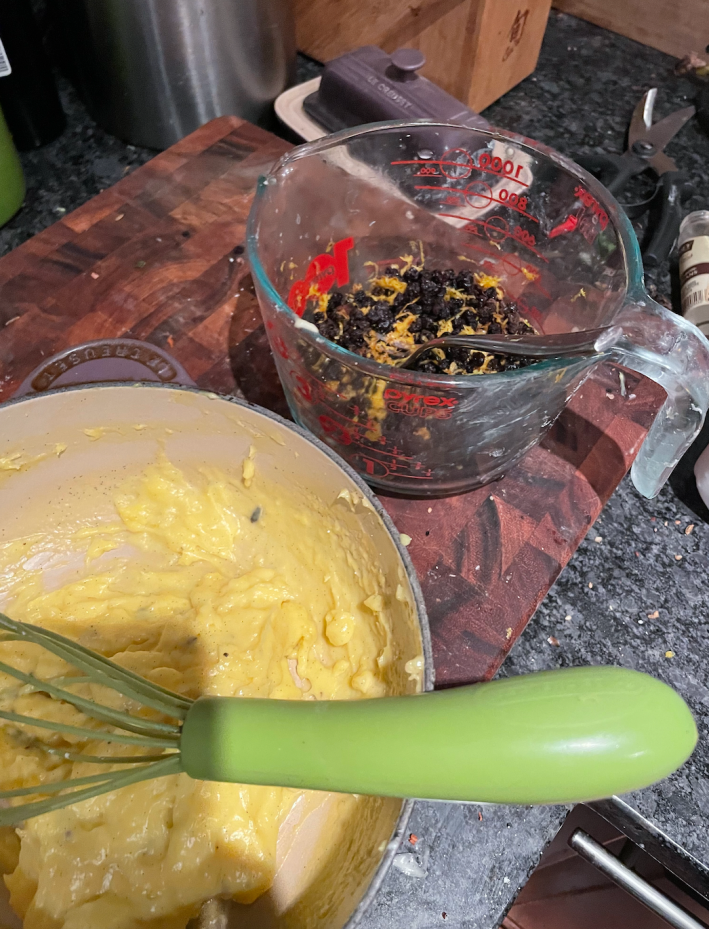
CT: I didn’t know much about making crème pat but I’ve made custard before, so I at least had a sense of what it should look like at the end. But the thing that allowed me to have success was a piece of weird information that I possess, thanks to the dreaded Albert Burneko. A few weeks ago, in a conversation about something he was cooking, he mentioned that cornstarch only thickens after it reaches a particular temperature, which I subsequently looked up because I thought he was wrong. He was not wrong. The temperature is 203 degrees.
So I kinda tempered the egg yolks and then threw it all in a saucepan and gently heated the mixture to 203 degrees using an instant-read digital thermometer. It thickened beautifully, I instantly pulled it off the heat and slapped some plastic wrap over it so it would not form any grody skin, and socked it into the refrigerator. Here again I felt like I could wield lightning.
KM: What the fuck? What kind of conversation were you having that this even came up? Simply heated to 203 degrees?
CT: Listen, it’s not even among the top 1,000 weirdest conversations I’ve had with dear Albert. With the crème pat finished, I was able to concentrate solely on laminating for the next three folds. I think I did three more? Or maybe just two more. But the process was straightforward: Pull the chilled dough envelope out of the freezer, roll it out pretty thin, fold, fold, wrap, and sock back into the freezer. At this point I was CRUISING.
KM: I did three folds but one of them was accidentally a double fold, in that I just went into a fugue state and folded it twice? I’m not really sure what happened there. I looked down and I had rolled it out after folding and my brain was like “This isn’t right,” so I just folded it again and put it back in the freezer. This, however, did not deter my confidence, because with every fold the dough looked better and better. I also want to note that my little currant/orange zest bowl smelled GREAT. I wish it were a candle. How did you apply your crème pat?
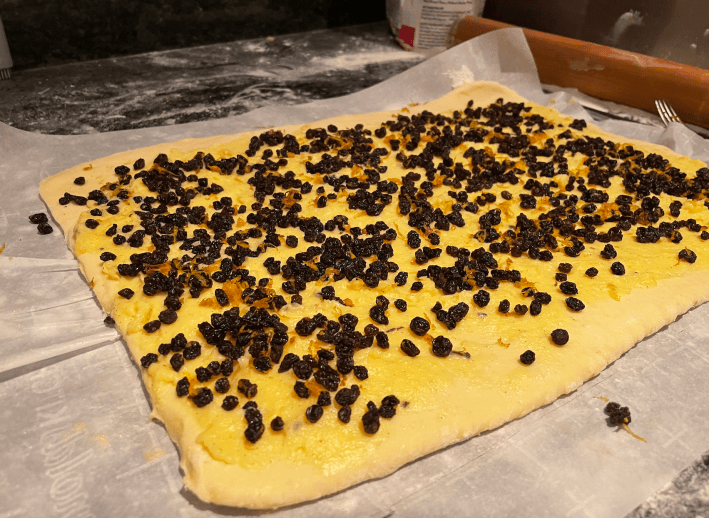
CT: After my final fold and chill, I had about 95 minutes left in my bake, which struck me as not much time at all considering that my dough would still need to prove. I pulled the dough out and quickly rolled it into a big squiggly-sided rectangle. Then I used a rubber spatula to kind of smear crème pat all over the place. I was worried a little because my crème pat was still slightly warm, but this was very straightforward. In fact, this was the final straightforward stage of this bake, for me.
KM: I also used a rubber spatula! It worked well. The dough was very stable, which was nice. I put my crème pat into the freezer with everything else, so it was pretty cold. Then I just like sprinkled all the delicious currants on top of the crème pat and rolled it. After 30 seconds of debating, I decided to roll the long side, which I later realized was maybe wrong because it was impossible for me to do the math of dividing 15 inches into six segments. So I just kind of eyeballed it.
CT: My dough was basically squared, but at any rate I did not have time to care about that, so I just grabbed the far end of the dough and started rolling. I didn’t have time to measure the cuts, either, so I just used my dough scraper to cut the rolled log in half, then cut each half in half, then cut each quarter into thirds, by eyeballing it. Things were getting fast and rough at this point. I had just over 80 minutes left on the clock, and I knew that I needed to prove my pastries, bake them, and then decorate them. I figured it would not be a long bake, somewhere between 12 and 25 minutes, but certainly not longer. With Paul Hollywood’s disappointed voice echoing in my mind, I decided that I would push it and give myself a full hour to prove my dough, reasoning that underbaked would be better than under-proved, as one of those indicates a lack of time and the other a lack of know-how.
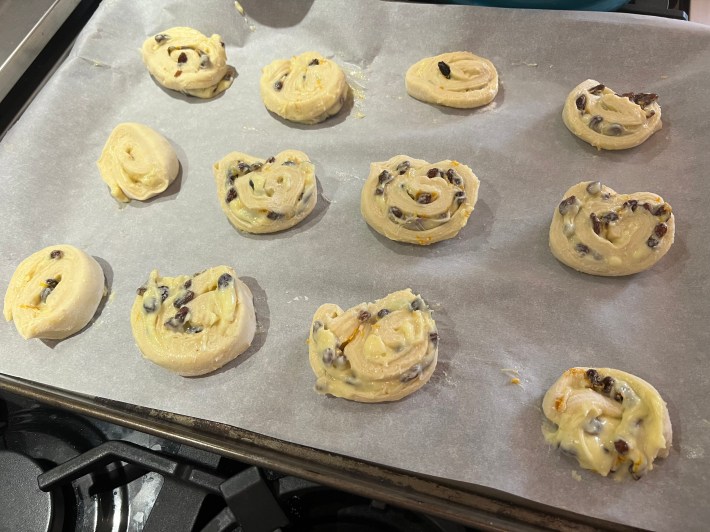
It was here, while considering how I wanted to prove my dough, that I grabbed a coffee mug on the counter and took a thirsty sip of what turned out to be raw egg whites.
KM: OH MY GOD HOW MANY RAW EGGS DID YOU EAT! Fuckin’ Gaston over here. It’s so funny you assumed up to 25 minutes because one of my fatal flaws in my count-backward time system is that I assumed the bake would take 18 minutes, or somewhere between 15 and 20, definitely not 25.
CT: I consumed just enough egg white to realize that I was consuming egg white, and then I shouted, “Jesus FUCKING Christ,” loud enough that my wife yelled down the stairs, “Everything OK?”
KM: Why had you put the egg whites into a mug?
CT: When I was separating the egg yolks for the crème pat I just reached up and grabbed a mug off the shelf to crack the whites into, and then I just … left it on the counter.
KM: I did this once with grease, and will never do it again, so I understand and do not envy your plight. One goblin behavior that I did is because I didn't have “oiled proving bags” (what the fuck is this?), I just tossed some clean kitchen rags on top of my newly cut rolls and let them sit on top of the stove while I waited. I am still growing accustomed to my new kitchen. In my old kitchen the stove only had two temperatures (low and high) and also it leaked so much heat. So this was not exactly as warm as I had expected it to be.
CT: Yeah, see, this is where I really felt lost. I also did not have proving bags, so I just spread cling wrap over my baking sheet (I used just one baking sheet). But because the cling wrap was really bad, it never much actually sealed the pastries, so they were open to the air of the kitchen. Then I also wasn’t sure whether I should prove them just out on the counter, or on top of the stove, or in the fridge, or what. I quickly decided that the fridge was not an option, not because of any knowledge of science but because there was not room. From there, I kinda jammed them into a space on the counter and set the timer for 60 minutes. It was all guesswork at this point.
KM: I did really second-guess myself at the point where my pastries were ready to prove and I still had like an hour and 30 minutes left. This felt like too much time. At this point, I think I even asked you how long you proved for because I think that people do that in the tent and you can’t convince me otherwise. But you also proved for an hour! What did you with your hour of free time?
CT: I was super impressed when you told me you had so much time left to prove and bake. You really kicked ass on the dough and laminating parts of this challenge. I used the proving time to clean and straighten a super chaotic kitchen, and then of course I read many blogs.
KM: After starting off so nervous and defeated, I really turned a corner when the laminating worked. You did too! You shifted from “I’m miserable” to “I’m the greatest baker to live,” at about the same point I did.
I also cleaned the kitchen. I had so much time that it was basically spotless. Trey came down at this point and I was hunched over my computer reading blogs in a spotless kitchen, and after listening to me bitch and moan for a full three days about this bake, he was like, “Oh wow!” Then I told him I was going to fight Paul Hollywood and God in that order, and he left me to my bake.
CT: Did you feel like you got much rise in your proving? Did your yeast do anything observable? Because mine super did not. One hour later they looked basically exactly the same.
KM: Not really. I took a picture of the dough before the prove and after so I could see if they rose, and by how much. But the difference was so subtle that flipping between them felt like those slideshows of whether a celebrity had a nose job or not. They looked a little puffier, but not much. My dough however had poofed up a bit throughout the lamination process, so it was a little poofy by the time I rolled.
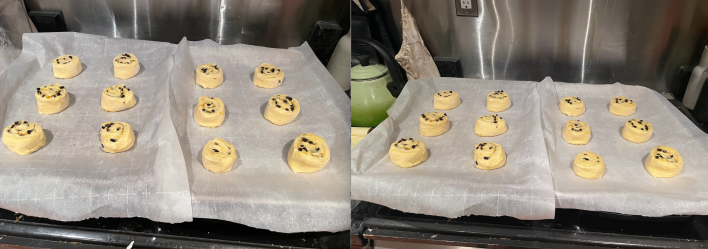
CT: My pastries went into the oven with precisely 22 minutes left on the clock.
KM: Mine was not that much better. I waited so long during the prove, the full hour. So I had 27 minutes left when my lil' pastries went into the oven.
Stage Two: The Bake
KM: I was so uncertain what was happening with the timing of these pastries that I set my first timer for eight minutes. I figured at that point I could flip my baking sheets in the oven so everyone would get equally toasty. I was basically entirely operating off a perhaps incorrect memory that the Pillsbury tin croissants that you roll yourself take 15 minutes to bake.
CT: There wasn’t much to do during the bake, for a change, so this time I was pretty much going off of how they looked in the oven, with a drop-dead limit of 21 minutes and 30 seconds. I went ahead and made my icing in the first couple minutes, just to get it out of the way.
KM: I literally crouched on the floor like a catcher and watched my little pastries. I had made my icing during the prove. I forgot to mention that because it was so boring.
CT: I fucked up the icing.
KM: WHAT!
CT: Yes, the lede to this blog is not quite a parable. The ingredients said “juice of one orange,” so naturally I sifted 200 grams of icing sugar into a bowl and then fully juiced my large orange into the bowl, and began to stir.
KM: Oh, I also did this. It was too runny, so I dumped a bunch more icing sugar in there. It’s funny that we did the same thing but I was like “this is fine” the whole time.
CT: I did add more sugar, but at a certain point I became worried that I would lose track of the bake if I pursued this too much longer. Also, I think I resented that the ingredients said “juice of one orange,” when what was actually required was the juice of approximately one-eighth of one orange.
KM: I did not have another orange, so I did not have much of a choice, to be honest.
CT: My icing wound up being very, very runny, but I gave up on it and focused on watching the pastries in the oven.
KM: At eight minutes, I moved my pastries. They looked doughy as hell. At this point I waved my arm in front of the oven while it was open. It did not feel hot enough to me. Do I have an “oven thermometer?” Do I look like a scientist? Of course I don’t have a fucking oven thermometer. I lived for eight years in a kitchen with an oven that was not digital, where the spinning thermometer dial did not have any numbers on it, because I accidentally cleaned them off. Temperature is a state of mind. Anyway, convinced that my oven was running cold, I upped the heat to 450. This felt more appropriate to me when I again moved my pastries at the 16-minute mark and they were still doughy.
CT: I never moved my pastries, but I did observe at about the 14-minute mark that they were a long way from finished. They’d expanded a lot and dropped some butter, but they were not browning at all and I was running out of time.
KM: Were they all still on one baking sheet, or did you move them?
CT: They were on one gigantic baking sheet. My oven is pretty huge, thankfully, even if it is extremely unreliable, temperature-wise.
KM: Wow, that’s sick. I watched my pastries as they did a little dance for me. First their middles remained up high while the sides dropped, and then they too collapsed, and finally the whole thing puffed up a bit. It was very satisfying to watch. But at the 23-minute mark, they were just getting color, so I left them in even though there were only four minutes on the clock.
CT: Yeah, I turned the heat up to 425 at the 15-minute mark, and I also switched from “Low Bake,” which just uses the heating element at the bottom of the oven, to “High Bake,” which uses the bottom and the top. This is always terrifying, because in my experience this tends to broil the bejeezus out of whatever is being baked in there. But at this point I needed some goddamn browning and I needed it PRONTO.
KM: I think my oven has this feature, but I don’t know how to use it because I have been living in (apparently) 1945 for a full decade. Can you teach me how to make it on high bake?
CT: Yes, you see, one simply turns the dial from “Low Bake” to “High Bake.”
KM: OK, see, I would. But my stupid space oven only has buttons. I hate it. It is not for me. One day, when I am old and rich, I will replace it with an oven with knobs. Anyway, I was forced to pull mine out before I wanted because there were only 45 seconds left on my timer.
CT: I was freaking out at the 21-minute mark, because I knew my pastries would not reach optimal color in time.
KM: I think given two more minutes each, we would be given star baker.
CT: I think you’re right!
Stage Three: Icing and Finishing
CT: How’d your icing work out?
KM: Well, Chris. I still do not have icing piping bags, obviously. So I dumped my icing into a Ziploc bag. It was rather runny. Too runny. But because there were literally 30 seconds left by the time I got my pastries onto the little cooling rack, I chopped off the corner of the bag with a cleaver and just zagged it across the pastries. It didn’t matter that it was uneven and would have looked like shit, because the pastries were so warm that it melted on impact. How did yours work?
CT: It honestly never even occurred to me to use a piping bag. I just … dipped a spoon into the bowl and flung the icing all over the place. My pastries were steaming hot, so the runny icing just immediately melted down and absorbed into the pastries, exacerbating the problem that they weren’t yet browned in the middle, really at all.
KM: That seems fine, considering both our icing melted anyway. I have to admit that when the timer went off, I took a really big inhale and holy shit these smell amazing.
CT: Yeah! I felt bad when the timer went off because I knew I’d come SO CLOSE to what I would’ve considered perfect pastries. But then immediately I smelled them and took a long look at them and I just absolutely could not wait to eat one.
KM: I am begging you to remember how afraid we were of this challenge, and how horribly wrong our lamination could have gone, and how good our pastries looked at the end. Please be nice to my friend Chris.
The Finished Product
CT: Show pastries? How were your pastries?
KM: OK, here they are:
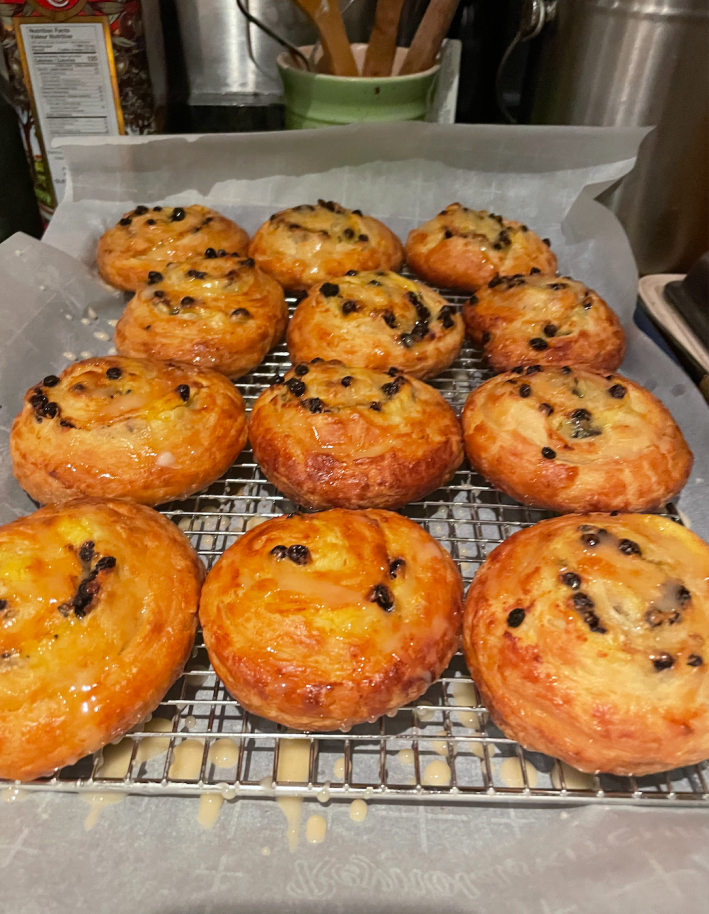
I have to admit, I have rarely been more proud of myself than I was after completing these. I was filled with adrenaline. I took one of my pastries and put it on a little plate and took it outside to take its photo in the sunlight. My dog followed me to do this sniffing because it smelled so great. It was too hot to eat at first.
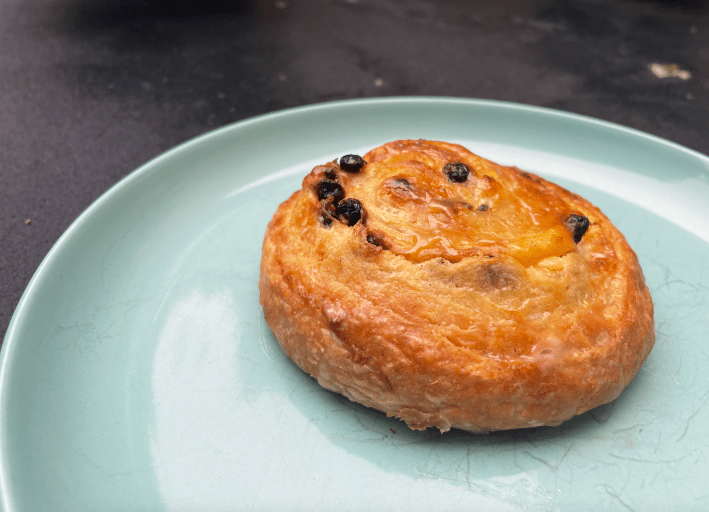
You show pastries?
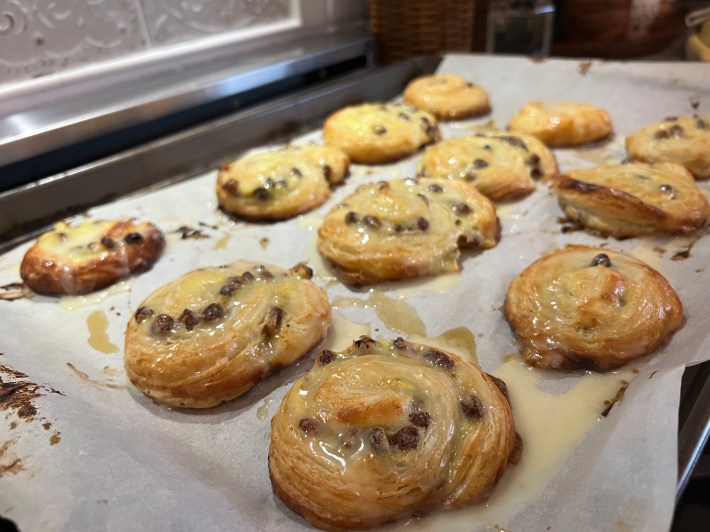
CT: My pastries are not as lovely and photogenic as they could’ve been given another couple minutes of baking. But the lamination worked really well, they had that flaky crunch and were super buttery, and they tasted really goddamn great. I have to give props to my mortal enemy, Paul Hollywood: He may have ambushed us very rudely with this non-bread recipe during Bread Week, but the man knows his way around a pastry.
KM: As soon as I was done photographing my pastry, I sliced it open, and at first my heart dropped in terror because I thought it was filled with raw dough. I was going to cry. This was the worst thing that had ever happened to me. But then I poked it and it was crème pat, so instead I gobbled it up like a little monster and it tasted INCREDIBLE.
CT: The orange hints in the icing and in the raisin mixture are so nice, and the crème pat is so ridiculously luxurious. These are almost certainly the best things I’ve ever baked. Within 14 minutes of removing them from the oven, my wife and small child and I had consumed four of them.

KM: It felt a little bit like a holiday treat to me. I honestly might make these at Christmas. They were delicious and with 10 more minutes, I think they would be perfectly bronzed! You’re right: Paul Hollywood is our enemy, but he is also a good baker.
CT: Are we proper chuffed? Is this how it feels to be proper chuffed?
KM: This is feeling proper chuffed, innit? Cheerio to you, ol' chap! Until next week, which … am I reading this correctly? Does this say … Mexican week?
CT: What?!
KM: Nos vemos, I guess!
If you liked this blog, please share it! Your referrals help Defector reach new readers, and those new readers always get a few free blogs before encountering our paywall.
Staff Writer
Staff Writer
Read More:
Stay in touch
Sign up for our free newsletter




